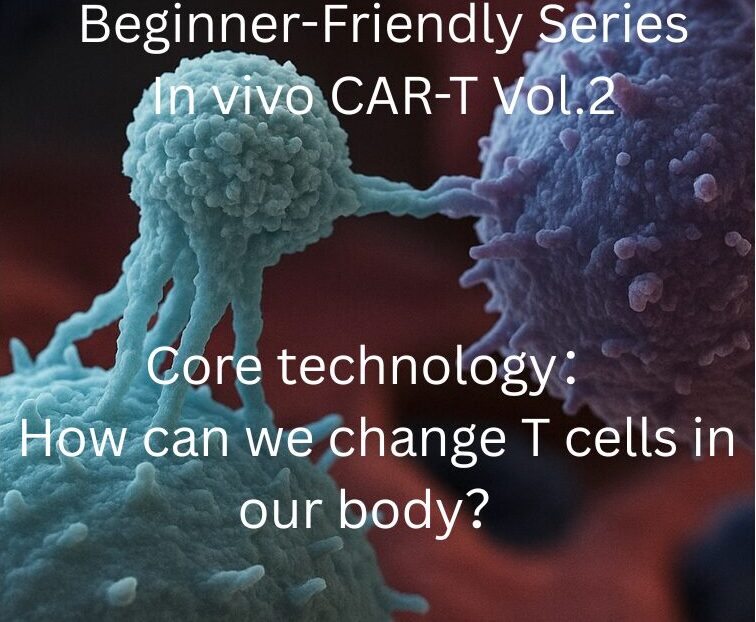In the first installment of our series, we introduced the revolutionary CAR-T cell therapy through the moving story of Emily Whitehead. This time, we take a deep dive into the underlying technologies that make “in vivo CAR-T” possible. From mRNA design to delivery vectors and promoter elements—these key components are shaping the future of immunotherapy.
Table of Contents
- 1. What Makes In Vivo CAR-T Unique?
- 2. mRNA Design: Optimizing for In Vivo Expression
- 3. Vector Technologies: Delivering Genes Safely and Effectively
- 4. Promoters and Tissue-Specific Control
- 5. Challenges and Future Directions
- 6. Conclusion and What’s Next
1. What Makes In Vivo CAR-T Unique?
Traditional CAR-T cell therapy involves extracting T cells from a patient, modifying them in a lab to express a Chimeric Antigen Receptor (CAR), expanding them, and reinfusing them into the patient. In contrast, in vivo CAR-T aims to simplify this entire process by introducing the CAR gene directly into T cells inside the patient’s body.
This innovative approach requires cutting-edge technologies to ensure the CAR gene reaches T cells specifically, without affecting other cells. To achieve this, mRNA design, gene delivery vectors, and expression regulation elements such as promoters play essential roles.
2. mRNA Design: Optimizing for In Vivo Expression
At the heart of in vivo CAR-T is the design of mRNA or DNA that encodes the CAR. Unlike ex vivo methods that allow careful laboratory-based gene transfer, in vivo techniques must ensure efficient expression inside living organisms. Key strategies include:
- Codon optimization: Adjusting sequences to match human codon usage enhances translation efficiency.
- UTR (Untranslated Region) tuning: Modifying 5’ and 3’ UTRs can control mRNA stability and translation speed.
- Modified nucleotides: Replacing uridine with pseudouridine helps reduce innate immune responses.
These mRNA engineering techniques are essential to achieving safe, stable, and high-level CAR expression inside the body.
3. Vector Technologies: Delivering Genes Safely and Effectively
Even the most perfectly designed mRNA is useless without a reliable delivery system. Currently, two major technologies dominate the field:
- Lipid Nanoparticles (LNPs): Widely used in mRNA vaccines (like COVID-19), LNPs encapsulate mRNA and facilitate uptake by immune cells.
- Viral Vectors (e.g., AAV, lentivirus): Engineered viruses can deliver genes into specific cells, but raise concerns about long-term expression and safety.
Each vector type has trade-offs: LNPs are safer and transient but less targeted; viral vectors are highly efficient but risk insertional mutagenesis. Research is ongoing to create hybrid or targeted vectors for in vivo CAR-T.
4. Promoters and Tissue-Specific Control
Another important aspect is “when” and “where” the CAR is expressed. Using appropriate promoter sequences allows researchers to control CAR expression, ideally restricting it to T cells. Key promoter strategies include:
- CD3ε or CD4/CD8 promoters: These limit expression to T lymphocytes.
- Inducible systems: Expression only occurs after a trigger (e.g., a drug or tumor-specific microRNA).
Such precision reduces off-target effects and enhances the safety of in vivo CAR-T therapies.
5. Challenges and Future Directions
Despite the promise, in vivo CAR-T still faces multiple hurdles:
- Ensuring T cell specificity in gene delivery
- Preventing immune responses against delivery systems
- Balancing efficacy and safety in transient expression
Companies like Intellia, Capstan, and Vector BioPharma are racing to develop clinical-grade in vivo CAR-T platforms. Early trials are showing encouraging data, but further innovation is needed to achieve broad and safe application.
6. Conclusion and What’s Next
In vivo CAR-T has the potential to overcome the logistical and cost challenges of traditional cell therapies. By refining mRNA design, delivery vectors, and regulatory elements, researchers are pushing the boundaries of cancer immunotherapy.
In the next article, we’ll explore clinical development trends and look into which cancers and diseases are being targeted first by in vivo CAR-T candidates.
🔗 Related Articles
- 【Series #1】Emily’s Miracle: A Beginner’s Guide to CAR-T
- Drug Development Trends 2025
- Beginner-Friendly Intro Series – Archive
This article was produced by the editorial team at Morningglorysciences.











Comments